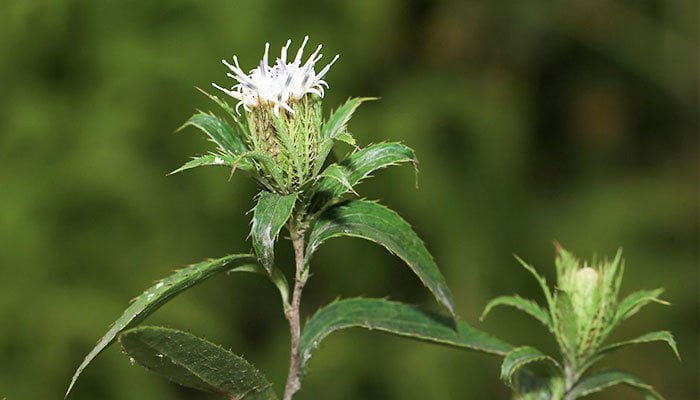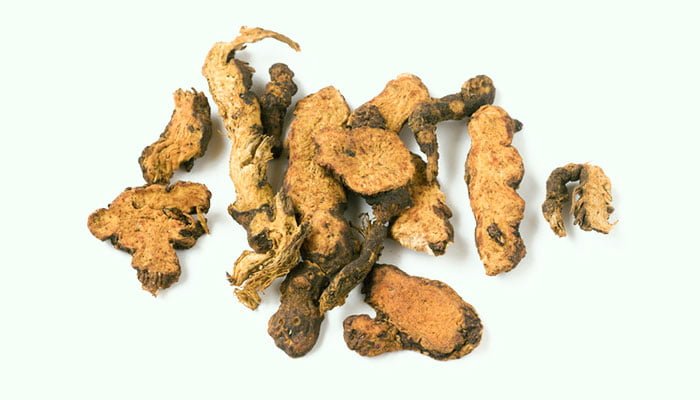What Is Cang Zhu
Cang Zhu commonly known as Rhizoma Atractylodis is the rhizome of Atractylodes lancea or Atractylodes chinensis, which is a perennial herb belonging to the family Compositae. It is a relatively practical and common Chinese herbal medicine, which first appeared in <Shennong Ben Cao Jing> in the late Western Han Dynasty (around 100 BCE).
There are about 7 species of Atractylodes, which are widely distributed in eastern Asia. Most of them are medicinally available.
Atractylodes lancea prefers cool climates. They often grow in sparse forests, bushes, or grasses on low hills and shady slopes. They are vigorous and can be planted on barren hills, sloping fields, or thin fields. They grow well in sandy loam soils with good drainage, low water table, and loose structure rich in humus. They are distributed in north-central China, south-central China, southeastern China, Korea, Japan, and the Russian Far East.

Atractylodes chinensis often grow on dry hillsides, sparse broad-leaved forests, or mixed coniferous and broad-leaved forests at an altitude of 300-900 meters. They are mainly distributed in northern China.
In spring and autumn, people gather the rhizomes of Atractylodes lancea or Atractylodes chinensis, remove impurities and their fibrous roots, wash them with water, cut them into thick slices, dry them in the sun, or stir-fry them with bran, make them into Chinese herbal medicines.
Cang Zhu contains atractyloside A, 10-epi-atractyloside A, atractyloside B, β-eudesmol, decalone, cholest-4-en-6-one, cholest-5-en-4-one, cholestan-2-one, atractylon, atractylenolideⅠ~ Ⅳ, atractyloside I, officinoside C, atractyloside C, atractyloside D, atractyloside E, diacetyl-atractylodiol, 9-nor-atractylodin, atractylodin, stigmasterol, daucosterol, β-sitosterol, traxerol acetate, φ-traxasteryl acetate, oleanolic acid, dihydropyridine, syringin, osthol, L-phenylalanine, D-tryptophan, hinesol, wogonin, and palmitic acid.
Generally, Cang Zhu with a gray-white or yellow-white cross-section, and a strong aroma is preferred.
According to <Compendium of Materia Medica>, the medicinal nature of Cang Zhu is relatively warm, with a pungent and bitter taste. It has a certain therapeutic effect on the pathological changes of the spleen, stomach, and liver meridians.
In traditional Chinese medicine, it is often used to dry dampness and invigorate the spleen, expel wind and cold, improve eyesight, and treat abdominal distention and pain, dyspepsia, vomiting, diarrhea, edema, beriberi, nyctalopia, rheumatic arthritis, gouty arthritis, infertility, polycystic ovarian syndrome, primary dysmenorrhea, abnormal leukorrhea, eczema, erysipelas, wind-cold, chronic bronchitis, gastroptosis, gastric ulcer, child anorexia, diabetes, senile obesity, nasal polyp, tinnitus, ichthyosis, and burns.
There are about 300 kinds of traditional Chinese medicine prescriptions containing it, such as Ping Wei San, Jiu Wei Qiang Huo Tang, and Si Miao San.
Benefits
- Anti-inflammation, inhibiting xylene-induced ear swelling and carrageenan-induced paw swelling in mice.
- Increasing the pain threshold, reducing the number of writhing induced by acetic acid, and prolonging the latency of tail-flick responses to thermal stimulation in mice.
- Inhibiting gastric acid secretion, increasing gastric mucosal blood flow, gastrin, and trefoil factor levels, promoting gastric mucosal repair, and inhibiting the formation of various ulcers (Such as pyloric ligation ulcers, flooding stress ulcers, hydrochloric acid ulcers, and indomethacin-ethanol ulcers).
- Promoting gastric emptying and neostigmine-induced slow gastrointestinal propulsion in mice, and antagonizing rhubarb-induced gastrointestinal hyperpropulsion.
- Inhibiting diarrhea induced by castor oil or senna leaf in mice.
- Reducing CCL4 or LPS-induced acute liver injury in mice and protecting the liver.
- Reducing the blood sugar level of alloxan hyperglycemia model mice, inhibiting the hydrolysis of sucrose by intestinal sucrase, and reducing the absorption of glucose in diabetic patients.
- Drying dampness and invigorating the spleen, treating abdominal distention and pain, nausea, vomiting, lack of appetite, diarrhea, white and greasy tongue fur caused by damp retention in middle-jiao, or dysfunction of spleen in transportation.
- Treating phlegm and fluid retention, diarrhea, and edema caused by excessive dampness due to deficiency in spleen, or internal retention of water-dampness.
- Dispelling dampness and treating rheumatic arthralgia, barbiers, and atrophy-flaccidity disease.
- Relieving exterior symptoms and dispelling cold, treating fever, aversion to cold, headache, and nasal congestion caused by wind-cold.
- Improving eyesight, relieving dry eyes and blurred vision, and treating night blindness and keratomalacia.
- Inhibiting the proliferation of lung cancer A549 cells, gastric cancer BGC-823 cells, gastric cancer SGC-7901, HepG 2 cells, melanoma B16 cells, cervical cancer HeLa cells, and cervical cancer SKOV-3 cells.
Inhibiting Pseudomonas aeruginosa, Candida albicans, Methicillin-resistant Staphylococcus aureus, Staphylococcus aureus, Escherichia coli and Bacillus subtilis. - Its n-butanol extract can improve the arrhythmia caused by myocardial ischemia and ischemia-reperfusion in rats, reduce the activity of plasma SOD after myocardial ischemia and ischemia-reperfusion, and reduce the scope of myocardial infarction.
- Studies have found that its acetone extract can significantly prolong the survival time of potassium cyanide poisoned mice. This indicates that its acetone extract has a strong anti-hypoxia effect.
Combinations
- It can be used in combination with Hou Po (Magnolia Bark), Chen Pi (Tangerine Peel), etc. to treat abdominal distention and pain, nausea, vomiting, lack of appetite, diarrhea, white and greasy tongue fur caused by damp retention in middle-jiao, or dysfunction of spleen in transportation.
- It can be used in combination with Fu Ling (Poria), Ze Xie (Rhizoma Alismatis), Zhu Ling (Polyporus), etc. to treat phlegm and fluid retention, diarrhea, and edema caused by excessive dampness due to deficiency in spleen, or internal retention of water-dampness.
- It can be used in combination with Shi Gao (Gypsum) and Zhi Mu (Rhizoma Anemarrhenae), etc. to treat arthralgia caused by damp heat.
- It can be used in combination with Huang Bai (Cortex Phellodendri), Yi Yi Ren (Semen Coicis), Niu Xi (Radix Achyranthis Bidentatae), etc. to treat swollen feet and flaccidity of feet caused by dampness-heat in the lower jiao.
- It can be used in combination with Long Dan Cao (Radix Gentianae), Huang Qin (Radix Scutellariae), and Zhi Zi (Fructus Gardeniae), etc. to treat leukorrhea and eczema caused by damp heat.
- It can be used in combination with Qiang Huo (Rhizoma et Radix Notopterygii), Bai Zhi (Radix Angelicae Dahuricae), and Fang Feng (Radix Saposhnikoviae), etc. to treat fever, aversion to cold, headache, and nasal congestion caused by wind-cold.
Side Effects
At present, there are no reports in the literature that Cang Zhu has toxic effects, and there are no reports of serious adverse reactions when it is taken according to the prescribed dose.
Precautions and Warnings
- The dosage of Cang Zhu should be controlled at 3-9g.
- It can be made into decoctions, pills, powders, or medicinal liquors.
- People who are allergic to Cang Zhu should not take it.
- Patients with internal heat due to yin deficiency should not take it.
- Patients with hyperhidrosis due to qi deficiency should not take it.
- Pregnant and breastfeeding women should take it under the guidance of a doctor.
